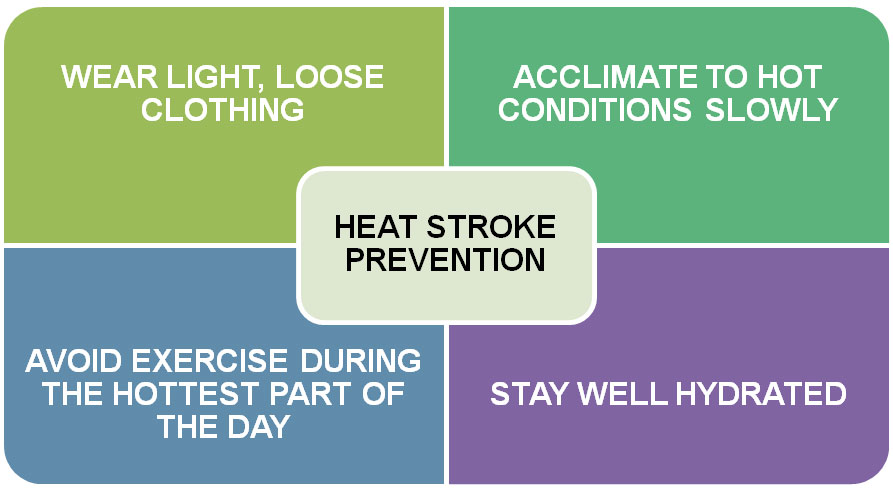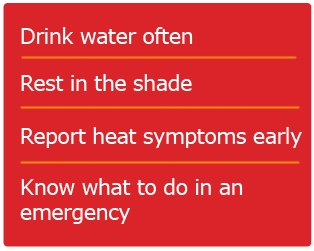Heat Awareness Day occurs the last Friday in May instead of the first weekend in July because prevention is better than cure. Once the rains calm down across America, it’s predictable what will happen next: heat, more heat and all heat, and you’d better be ready. The way things work, we just have to deal with it. Unlike when the weather is cold, and you can just add layers, when it’s extremely hot, it seems unescapable. So we sweat, get fatigued and even cramp up. Surprisingly there appears not to be much thought given to the notion that heat cramps are an early sign of a life threatening condition, even though many of us have had loved ones die from heat related illnesses.
When a loved one dies, families often ask “Is there something I could have done?” Usually I give you information. Today’s Straight, No Chaser will give you information and power to act if needed. There are several varieties of heat-related illness, and you would do well to be aware of them, because you can make a difference if someone’s suffering in the heat.
For starters, I really want you to become mindful of Heat Stress, which is the earliest complex of problems arising from excessive heat exposure. Heat stress is that strain and discomfort you get (usually during outdoor exertional activity) that reminds you that you’d be better off inside (assuming it’s cooler inside). You may notice such symptoms as cramping, a prickly-type rash, swelling and a sensation that you want to lose consciousness. If you must remain outdoors due to work, or choose to (playing sports or enjoying the sun), hydration means everything. It really is true that in some instances if you’re not actively urinating, you’re not drinking enough fluid. (This is the level at which LeBron James was suffering, and it really does beg the question as to why he was allowed to suffer on the sidelines instead of being taken to the locker room, iced down and given intravenous fluids.)
Ok, so you’ve ignored both me and your body, and you’re still outdoors, not rehydrating enough. Heat exhaustion may occur next, and it’s defined by ongoing body salt and fluid losses. Now you’re feeling faint, thirsty, anxious, weak, dizzy, you want to vomit and may have a headache, and your body temperature starts to climb. I see a lot of these patients, usually because once you get wobbly, your employers or co-workers are getting concerned, which is good, because at this point, you are actually in danger.
Or maybe you didn’t come to see me when you had the chance, and you’ve collapsed outdoors, to be found and brought in. This is Heat Stroke, and is defined by changes in your mental status, increases in your temperature and disruption of your bodily functions, including a loss of ability to sweat and a loss of your kidney and liver’s abilities to detoxify your body the way they normally do.
Well, in case you’re feeling good about yourself because you’re too smart to exert yourself outdoors, all I’ve been describing is ‘Exertional’ Heat Stroke. The more deadly form of heat related illness is ‘Classic’ Heat Stroke. This is the type that captures the headlines every year in places like Chicago, New Orleans, Miami and Houston. Classic Heat Stroke is seen in those with underlying disease, bad habits or the elderly. I’m talking about the obese, alcoholics, meth and/or cocaine users, folks with thyroid or heart disease or on certain medications like diuretics or beta-blockers. These folks can get the same symptoms simply by not being able to escape the heat. They may actually just be sitting around in a less than optimally air-conditioned home.
So that’s what you’re up against. And yes, many people die from this. By the way, you’re not protected from the heat related illness just because you’re in shape. Let’s end with some 2 tips (one for prevention and the other for assessment and treatment) to help you Beat the Heat.
1) Take special caution during the following conditions
- 95 degrees is high risk, regardless of the humidity
- 85 degrees and 60% or above humidity
- 75 degrees and 90% or above humidity
Here, you want to remove yourself from that environment. You need to keep plenty of fluids around. You need to visit an environment where there’s adequate air conditioning. Dress very lightly.
2) If symptoms of heat related illness short of mental status changes occur, think “Check, Call, Care, Cool”
- Check – look for those signs and symptoms I mentioned earlier
- Call – call 911 immediately. Better to have it and not need it than need it and not have it.
- Care – Lie in a cool place, elevate the legs, place cool, wet towels on the body (especially in the armpits and groin), and drink cool fluids. If mental status changes occur, or if the heart or lungs appear to give out, cool by any means necessary while waiting for the ambulance. This could include ice bath, ice packs, fans or cold water, but don’t drown someone trying to put them in a tub of water if you can’t handle them. Don’t forget to remove those layers of clothing.
Please be mindful that it is hotter in July, and unfortunately lives are lost every year to the heat. That said, it doesn’t have to be July for you to get a heat-related illness. If you can’t avoid the exposure, at least have a plan for managing the heat and acting on any mishaps. The life you save may be your own.
Feel free to ask your SMA expert consultant any questions you may have on this topic.
Order your copy of Dr. Sterling’s new book Behind The Curtain: A Peek at Life from within the ER at jeffreysterlingbooks.com, iTunes, Amazon, Barnes and Nobles and wherever books are sold.
Thanks for liking and following Straight, No Chaser! This public service provides a sample of what http://www.SterlingMedicalAdvice.com (SMA) and 844-SMA-TALK offers. Please share our page with your friends on WordPress, like us on Facebook @ SterlingMedicalAdvice.com and follow us on Twitter at @asksterlingmd.
Copyright © 2016 · Sterling Initiatives, LLC · Powered by WordPress





